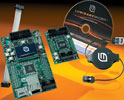

Luminary Micro has introduced 34 new Stellaris microcontrollers (MCUs), bringing networking and expanded control capabilities for realtime applications in motion control, fire and security, remote sensing, HVAC and building controls, power and energy monitoring and conversion, network appliances and switches, factory automation, electronic point-of-sale machines, test and measurement equipment, medical instrumentation and gaming equipment.
The new additions include 20 members of the LM3S1000 high pin-count realtime MCU series, 11 members of the LM3S8000 Ethernet+CAN internetworking series, and three new members of the LM3S6000 Ethernet series featuring hardware assist for IEEE 1588 Precision Time Protocol (PTP) support.
The LM3S1000 series features new combinations of expanded general purpose I/O, larger on-chip memory, and low-power optimisation for battery-backed applications.
The LM3S8000 devices combine both Ethernet media access control (MAC) and physical (PHY) layers with up to three CAN interfaces on-chip. Professional-grade motion control hardware is included in many of the new configurations, providing powerful solutions for connected motion applications.
Three of the new LM3S6000 Ethernet series MCUs and six of the new LM3S8000 Ethernet+CAN internetworking MCUs feature hardware assist for IEEE 1588 PTP support. The IEEE 1588 standard provides a mechanism for synchronising distributed realtime clocks in a packet-based multicast network such as Ethernet.
Time-based synchronisation is the preferred method for synchronising control systems (especially motion control) over networks because it is not as susceptible to jitter as other synchronisation methods and is also based on absolute time, making it easier to program. Additional benefits of this standard include the use of inexpensive network components, fault tolerance, hot plugging capability and self-configuration.
Networked variable frequency drives require synchronisation accuracy in the tens of milliseconds, and servo-controlled systems require accuracy in the few hundreds of nanoseconds. Stellaris implementations using the open source lwIP TCP/IP stack and open source 1588 PTPd stack achieve within 500 nS synchronisation accuracy, said to be a greater than tenfold improvement over typical software-only implementations.
Also available are two complete evaluation kits: the Stellaris LM3S1968 Evaluation Kit and the Stellaris LM3S8962 Ethernet+CAN Evaluation Kit. Each kit includes evaluation boards, all required cables, a choice of evaluation tools suites for popular development tools, documentation, a Peripheral Driver Library and applications notes. Both kits span the design spectrum from evaluation to prototyping to application-specific design by functioning both as an evaluation platform and as a serial in-circuit debug interface for any Stellaris microcontroller-based target board.
| Tel: | +27 11 608 0144 |
| Email: | [email protected] |
| www: | www.nuvisionelec.com |
| Articles: | More information and articles about NuVision Electronics |

© Technews Publishing (Pty) Ltd | All Rights Reserved